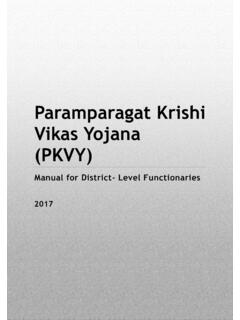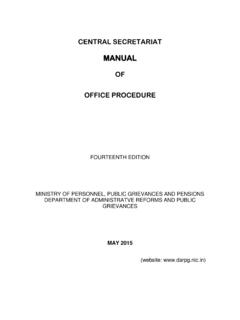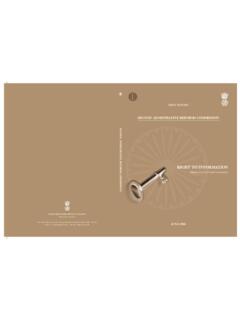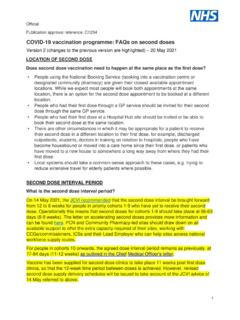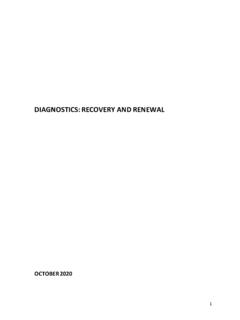Transcription of National Health Mission (NHM)
1 I National Health Mission (NHM) Manual for District- Level Functionaries 2017 ii PREFACE The purpose of this Development Manual for National Health Mission (NHM) is to create an enabling mechanism for improved implementation of the Centrally Sponsored Scheme (CSS) at the cutting edge, leading to enhanced outcomes in nature and extent. Accordingly, it would act as a guide for implementation by the District Collector and key District-level functionaries, enable quick learning about the Scheme, implementation modalities, roles and responsibilities of the various functionaries as well as stakeholders. This Manual is prepared with inputs from a combination of sources, such as review of scheme guidelines and circulars issued by the Ministry of Health & Family Welfare, the nodal Ministry for administration of the scheme, interaction with nodal officers from Ministry of Health & Family Welfare; Government of India (GoI), National Health Systems Resource Centre (NHSRC), District and Sub district level authorities and discussions with the key personnel involved in the implementation of the Scheme.
2 For greater direction, the guidelines cited must be referred to along with the scheme website ( ) for guidance and clarifications on implementation from time to time. 3 CONTENTS 1. National Health Mission (NHM) .. 4 National Health Mission (NHM): About the Scheme .. 4 2. National Rural Health Mission (NRHM) .. 4 Objectives, Goals and Key Strategies of the NRHM .. 4 Components .. 5 Convergence .. 15 Institutional Framework .. 17 Untied Funds .. 21 Fund Flow Management .. 22 District Health Action Plans (DHAP)/City Health Action Plan .. 23 Best Practices/ State 27 3. Roles and Responsibilities of Key District Level Functionaries.
3 29 Chair of District Health Society (DHS) (District Collector/ Magistrate) .. 29 Village/ Block/City / District/Ward Level Officers- programme Management Unit (PMU) .. 31 Block/City / District Level Officers- Community Process Unit .. 35 4. Accountability, Monitoring, and Reporting .. 39 Accountability Framework .. 39 Monitoring & Evaluation Activities .. 40 5. National Urban Health Mission (NUHM) .. 40 About the Scheme .. 42 Goals, Objectives and Strategies of NUHM .. 43 Institutional Framework: Resource Planning in NUHM .. 43 Convergence .. 44 Roles and Responsibilities of District Health Society in Urban Areas (NUHM).
4 45 NHM- IMPLEMENTATION MONITORING PROFORMA (YEARLY REVIEW SHEET with MONTHLY REPORT FORMAT) [For District Level Functionaries based on the District Action Plan (DAP)] .. 46 ABBREVIATIONS .. 51 ENDNOTES & REFERENCES .. 53 4 1. National Health Mission (NHM) National Health Mission (NHM): About the Scheme1 National Rural Health Mission (NRHM) was launched in April 12, 2005 to address the Health needs of the underserved rural population especially women, children and vulnerable sections of the society and to provide affordable, accessible and quality healthcare. The National Urban Health Mission , (NUHM) was launched in May 2013 and was subsumed with NRHM as a sub- Mission of the overarching National Health Mission .
5 (NHM). Many unique practices were encouraged like innovations in healthcare delivery practices, flexible financing to the states with strengthened monitoring and evaluation component for better Health outcomes and Health indicators of the states. The vision2 of the NHM is the Attainment of Universal Access to Equitable, Affordable and Quality Health care services, accountable and responsive to people s needs, with effective inter-sectoral convergent action to address the wider social determinants of Health . NHM focuses on decentralized Health planning, service delivery, creating knowledge hubs within district hospitals, strengthening secondary level care at district hospitals, expanding outreach services, improving community processes and behavior change communication, human resources development, public Health management, and Health management information systems.
6 NHM particularly focuses on equity: prioritizing the Health of tribal populations, those in LWE and urban poor. A key outcome of NHM is to reduce Out of Pocket expenditures. Health outcomes, output and process indicators are monitored through large scale surveys conducted periodically with evaluations, use of HMIS data, and periodic reviews done. The main aim is to create a fully functional, decentralized and community owned system with greater inter- sectoral coordination so that wider social determinant factors affecting Health of people like water, sanitation, nutrition, gender and education are also equally addressed.
7 2. National Rural Health Mission (NRHM) Objectives3, Goals4 and Key Strategies 5 of the NRHM Major Strategies were incorporated for improving outreach of Health services to public for greater synergy; decentralized planning and innovation in service delivery. The summary* of objectives, goals and strategies are in Table 1: Table 1: Objectives, Goals & Strategies of NRHM Objectives Goals Strategic Changes 5 1. Reduction in Infant Mortality Rate (IMR) and Maternal Mortality Rate (MMR 2. Population stabilization, gender and demographic balance 1. Reduce IMR to 25/ 1000 live births 2.. Prevention and reduction of anaemia in women aged 15- 49 years 3.)
8 Reduce Total Fertility Rate (TFR) to 4. Reduce MMR to 1/ 1000 live births 1. Strengthening infrastructure at all levels 2. Quality Monitoring of facilities as per Indian Public Health Standards ( IPHS) Standard 3. Decentralised planning with autonomy for local action 4. Institutional Mechanisms at all levels with autonomy 5. Induction of management specialist into programme management Units 6. Centralized technical support unit- National Health Resource Centre and State Health Resource Centre(NHSRC and SHSRC) 3. Achieve Universal access to public Health services like women s Health , child Health , water, sanitation & hygiene, immunization, and nutrition.
9 4. Promotion of healthy life styles 1. Reduce household out of-pocket expenditure on total Health care expenditure 1. Decentralised planning with autonomy for local action 2. Inter sector District Health Plan includes drinking water, sanitation, hygiene, nutrition Capacity- Building of Panchayati Raj institutions 3. Developing capacities for preventive Health care at all levels 5. Prevention and control of communicable and non- communicable diseases, including locally endemic diseases 1. Prevent and reduce mortality and morbidity from communicable, non- communicable, injuries and emergency diseases 2. Reduce annual incidence and mortality from Tuberculosis by half 3.
10 Reduce prevalence of Leprosy to <1/10000 population and incidence to zero in all districts 4. Annual Malaria incidence to be <1/1000 Less than 1 per cent microfilaria prevalence in all districts 5. Kala- Azar Elimination by 2015, <1case per 10000 population in all blocks 1. Integrating vertical Health and Family Welfare programmes 2. Developing capacities for preventive Health care at all levels 3. Reorienting Medical Education to Rural Health Issues 6. Access to integrated comprehensive primary healthcare 7. Revitalization of local Health traditions and mainstream AYUSH 1. Reduce household out of-pocket expenditure on total Health care expenditure 1.

